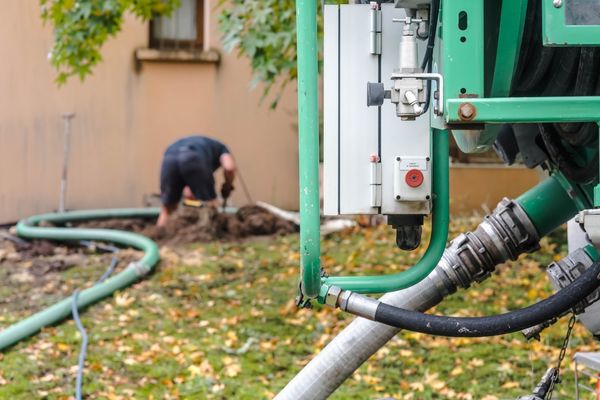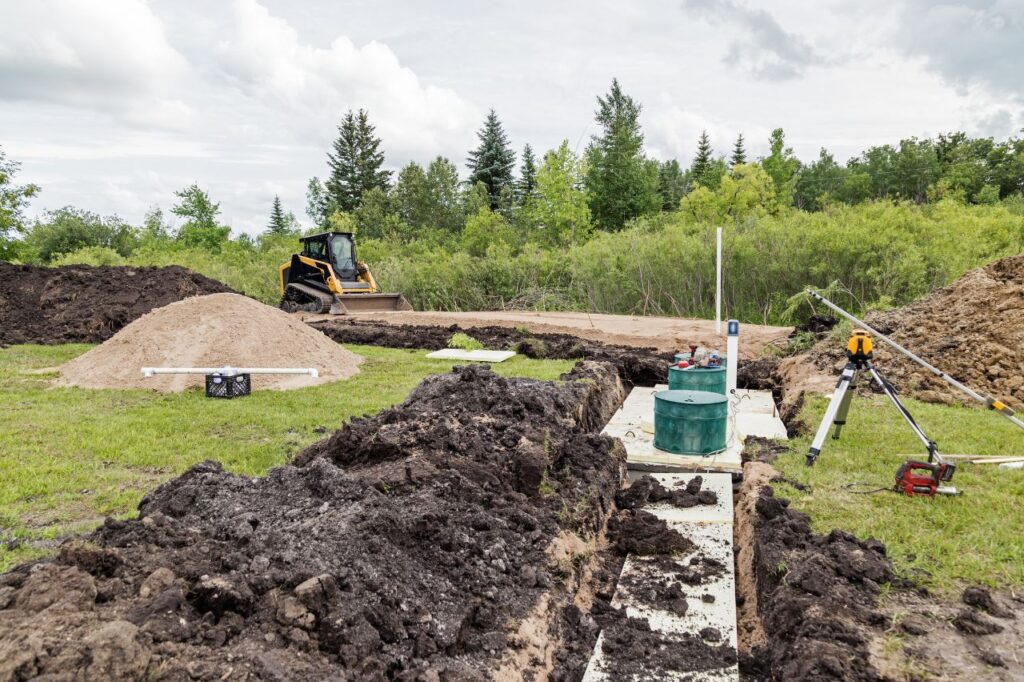Aerobic Treatment Units (ATUs), also known as home aeration systems and aeration systems, are a wastewater treatment option for households that cannot use septic systems. This is due to site or soil conditions which prevents anaerobic treatment. ATUs rely on oxygen to treat the wastewater, and thus require electricity to operate a mechanism that injects and circulates air into the tank. Consequently, they cost more to run than septic systems and require more routine maintenance; however, when run and kept up properly, they provide high-quality wastewater treatment options.
Table of Contents
ToggleWhy should someone choose aerated wastewater treatment (ATU) over a traditional septic tank-soil absorption system?
ATUs can be a good choice when installing on sites with limited land area or soil conditions, or where the water table is high. The treated wastewater from an aerobic unit is typically of higher quality and often regulations allow for it to be discharged into a nearby surface of body water. For example, when properly disinfected by a chlorinator, it can be sent out to a stream, which is a typical solution for failing septic systems in many areas. In addition, an ATU can renovate an existing drainfield and extend its life. However, it should be noted that the basic unit is usually more expensive than a septic tank and requires more maintenance – such as having to pump out the solids at more frequent intervals. Therefore, most ATUs come with manufacturer contracts for inspections and maintenance that must be extended for the life of the unit. All things considered, ATUs are not best suited for every situation but they do offer an alternative when traditional systems are not suitable due to site-related constraints.
How does an aerobic treatment system work?
Aerobic systems are wastewater treatment systems that use natural processes requiring oxygen in order to treat wastewater. This is accomplished by suspending a variety of bacteria, which thrive in oxygen-rich environments, into the liquid inside the unit and allowing them to digest the wastewater. The process of treating the wastewater usually involves multiple stages and may include preliminary treatments and disinfection before releasing it back into the environment. Different systems have different design features, but all share similar principles regarding how they work.
Pretreatment
Pretreatment is a crucial process that some aerobic wastewater treatment systems use to limit the solid material entering them. These solids may include things such as toilet paper and other products that enter the wastewater system either by being put down the drain or flushed in. Too much solid matter can clog up the unit, disrupting effective treatment and performance capabilities of an aerobic system. Pretreatment methods include septic tanks, a primary settling compartment in the unit itself, or a trash tank for taking out large solid matter that bacteria cannot break down. Incorporating pretreatment greatly enhances the performance of any aerobic unit.
Treatment
Aerobic treatment units (ATUs) are one way to treat household wastewater for disposal. These are usually buried underground and come in several shapes and sizes. In an ATU, wastewater is aerated with oxygen in an aeration chamber. This oxygen supports the growth of aerobic bacteria that breaks down the larger solids in the wastewater into smaller particles. The resulting mixture of wastewater and oxygen is referred to as mixed liquor. The bacteria cannot break down all solids in the mixture however, so those settle out as sludge which can accumulate at the bottom of the tank or be given a designated settling compartment or clarifier. The accumulated sludge is then recycled back into the aeration chamber where additional bacteria will aid further in treatment processes. Over time this process may need to be repeated as buildup occurs, requiring pumping of sludge from ATUs for optimal performance.
Flow
Flow control is a crucial part of wastewater treatment. In continuous flow designs, wastewater flows through the unit as quickly as it leaves the home. Other systems rely on pretreatment tanks, surge chambers and baffles to regulate the incoming amount of wastewater. Batch process designs use pumps or siphons to control how much wastewater moves into and out of the aeration tank while ensuring that quality of treatment is maintained. Unfortunately, mechanical flow control devices require regular maintenance and risk malfunctioning over time. Homeowners can help their system’s performance by conserving water; fixing any leaking faucets and running toilets, using full electricity when possible and installing water saving devices into toilets, faucets, and showers to reduce water use by up to half. Some activities require more water than others so homeowners should also attempt to space them out in order to not overload their systems.
Final Treatment
Final treatment and dispersal are the last steps in properly disposing of wastewater from an aerobic unit. Most commonly, this would be done through a soil absorption field, which uses bacteria in the soil to treat the wastewater naturally and helps stop clogging of the pores in the soil. Alternatively, other methods such as evapotranspiration beds, drip irrigation, sand filters or disinfection can also be used. Disinfection may even be the only required method of treatment before releasing wastewater into the environment, often done with either chlorination or ultraviolet (UV) disinfection being preferable for its lack of any residual effects.
Other Design Considerations
Alarms and Controls
In order to ensure the safe and proper functioning of an aerobic unit, important controls and alarms must be installed. Typically, these can be easily switched on and off by the homeowner in case of an emergency, while alarms alert them to any malfunctions in the system. Controls and alarms may be located either inside or outside of the home and may be displayed both visually and audibly. To maintain efficient operation, homeowners should regularly check that all controls and alarms are properly shielded from corrosion, as well as turning the unit back on if it experiences a power outage or is turned off temporarily.
What size Aerobic unit should be used?
Aerobic units are typically between 300 to 1,500 gallons per day. However, many regulations require that the unit be able to treat 500 gallons of wastewater daily. Generally, the number of bedrooms (not bathrooms), can equate to an estimate for the amount of water needed for usage. It is estimated that each bedroom will host two people, who will produce around 50 to 100 gallons of water a day. Therefore, in a three-bedroom house, it will require an aerobic unit with a capacity of 300 to 600 gallons per day. Additionally, some health departments require that the aerobic unit size must at least match the septic tank’s size – providing partial treatment if necessary, in case the aerobic unit malfunctions.
Temperature
Temperature plays an important role in the efficiency of aerobic treatment systems. Generally speaking, higher temperatures can speed up the biological processes and help to keep the treatment process active. However, temperatures that are too low (less than 15 degrees Celsius or 59 degrees Fahrenheit) can cause problems with some units and reduce performance. The best way to avoid this is by insulating around the units. If you’re unsure whether aerobic systems are suitable for your area, check with your local health department for more information.

Aerobic Treatment Units Maintenance
Proper maintenance of your Aerobic Treatment Unit is important to ensure optimal functioning of the system. Mechanical components in particular need regular inspection and servicing, such as oiling the aerators or replacing vanes, filters, and seals. Many homeowners don’t possess the necessary expertise to handle these tasks on their own. NSF-approved aerobic systems typically include two years of service visits in the purchase price, but it is advisable that service agreements are renewed after two years, or a new service provider is sought. In case of emergency servicing, replacement parts need to be stocked by the contractor and made available without any extra cost to the homeowner during these two years. Damage from forces beyond human control, misuse by homeowner and other catastrophes are not covered under original agreement. For correct management programs for aerobic systems, you may contact your local health department’s sanitary districts.
First Service Call
Immediately after your system has been installed, you should schedule a service visit to ensure that everything is in order. Your service contractor may wish to go over details such as correct operation, emergency procedures, and shut down/start up instructions for seasonal properties. Following the first visit, a maintenance contract will be issued which typically includes two annual visits for the following two years. During a typical service call, the technician will take off the cover and inspect all components, mechanical parts, and controls; examine chlorinators if applicable along with odor and color of wastewater and mixed liquor samples. Finally, your service provider will also inspect is soil absorption field or other treatment method for final processing purposes.
Keep Good Records
Service records are documents that detail the installation, maintenance, and repair of a particular system or service. These records may contain information such as manufacturer recommendations for the system, the type of disinfection used, state permitting license information, dates of installation and modification made to the system, and contact information for the owner in case nobody is home when service visits occur. It is recommended both for homeowners and service providers to keep complete copies of all records and permits relating to a system or service. The National Environmental Services Center offers convenient folders designed to store this important documentation.
Aerobic Treatment Unit FAQS

Do Aerobic Septic Systems Freeze?
As temperatures drop during the winter months, you may be wondering how your aerobic septic system will hold up. Don’t worry, aerobic septic systems are designed to work in cold weather and can stand up to freezing temperatures. However, there are certain precautions you should take so your system does its job safely and efficiently.
Identify potential risks of freezing temperatures
Aerobic septic tanks typically contain a pump and pipes, both of which could be adversely affected by freezing temperatures. If the tank or its components freeze, they can become clogged, leading to costly repairs and possibly even system failure. Therefore, you should take some steps prior to winter to ensure your aerobic septic system is winterized, such as installing insulation around the tank and its components.
Prevent septic system freezing during extreme cold weather
To help prevent freezing during extreme cold weather, you should install frost-free faucets, wrap pipes in insulation and make sure that your aerobic septic system is properly insulated. You may also want to turn off the pump or set it to a lower level during winter months. Additionally, keep your lawn trimmed away from the tank and pump to allow the sun’s rays to reach them more easily and reduce the chances of them freezing due to extended periods of cold weather.
Keep your system warm in the winter months
One way to keep your aerobic septic system from freezing during extreme cold weather is to ensure that it is properly insulated. Covering the tank and wrapping pipes in insulating material will help maintain a warmer temperature in the system and reduce the risk of freezing. Additionally, turning off or setting the pump to a lower level when temperatures drop too low may also be beneficial.
Learn about maintenance for an aerobic septic system in cold weather areas
Proper maintenance of an aerobic septic system in cold weather areas is essential to ensure that it does not freeze and preserves its function. Maintenance is important no matter the outside temperature, but it is even more crucial when temperatures dip below freezing. Regular inspections should be done to make sure that the tank, pump, and other components are all in working order before freezing temperatures arrive. Furthermore, any suspected damage should be addressed immediately to avoid potential issues in the future.

How Much Space is Required for An Aerobic Septic System Installation?
Aerobic septic systems require a certain amount of room to ensure the components are properly placed and will function correctly. Knowing the size requirements for an aerobic septic system installation is essential for homeowners considering an upgrade or new installation.
Determine the location:
Before you can begin installing an aerobic septic system, you must determine where the system will be located. In most cases, the area should be either elevated or leveled. The system should be installed at least 20 feet away from any structures, such as homes and garages, and 50 feet away from wells. A larger area may be required depending on local ordinances and laws. Furthermore, all-underground components must be buried at least 36 inches below grade, while surface components should be placed 18-24 inches above grade.
Calculate distance requirements:
Calculate the area of the septic system to be installed. Measure the length, width, and depth of the system to determine how much space is necessary for installation. Make sure your measurements meet local ordinances and zoning regulations. Additionally, you may need to calculate distances between buildings, wells, or other infrastructure in order to determine how far away your system will be located. This information should be used when designing the septic system layout.
Estimate the coverage of a typical aerobic septic system installation:
The coverage area for the typical aerobic septic system is about one acre (4,047 square meters). It is important to note that depending on local practices, the required size may be different from this estimate. In certain jurisdictions, the size requirement may be larger or smaller than one acre. Be sure to confirm your local requirements with a qualified professional before beginning installation.
Identify the depth and slope requirement for aerobic septic system installations:
Before beginning your aerobic septic system installation, you will need to determine the correct depth and slope for the project. The exact measurements depend on a few factors such as soil conditions, but generally it is recommended that the excavation for the system should be at least 24 inches deep with a slight tilt, or angle of about one-quarter inch per each foot away from drainfield. Confirm your local specifications with a qualified professional before starting installation.
Account for required access to the drain field or tank area:
Once your septic system is installed, you’ll need to account for access to the drain field or tank area. This can be accomplished by leaving a minimum of 12 inches of soil above the tank and then installing sod or other landscaping materials on top. This will allow easy access in case repair or maintenance is ever required. Be sure to specify this during installation so that adequate space is left unoccupied when complete.
Can You Move an Aerobic Septic System?
Moving an aerobic septic system can be a complex task, and caution should be taken when considering this type of project. We provide tips on gaining permits, planning the move, and other considerations to help make it easier and less stressful.
Why Would You Move an Aerobic Septic System?
There are a variety of reasons why you may want to move an aerobic septic system – this could include if you’re planning to expand your property or designating a new area for the system. If your current system is outdated and inefficient, it’s possible to upgrade and/or change the location of your existing tank. Moving an aerobic system should only be done for necessary reasons – contact a professional for advice specific to your situation before making any decisions.
Is it Legal to Move an Aerobic Septic System?
Relocating an aerobic septic system and its associated components requires approval from both local and state governments. Local authority approval is a priority, as regulations and requirements vary significantly between regions. Before the permit is issued, a professional will need to conduct a wastewater assessment to determine how the soiled water produced by your system can be safely disposed.
How Much Will It Cost to Move the Aerobic Septic System?
The cost of moving an aerobic septic system depends on several factors including the size of the tank, the complexity of the required work and the distance that it needs to be relocated. The typical cost for relocating aerial septic systems ranges from a few thousand dollars to as much as $10,000 or more. Before beginning any work, it is important to find out if a permit for relocation is necessary in your area and obtain an estimate from a professional installer.
Are There Benefits to Moving the Aerobic Septic System?
Moving an aerobic septic system can provide several benefits to the homeowner, including improved property value and a better functioning system due to improved soil conditions or easier access. Solutions such as compact foil-lined tank systems are designed specifically for landowners who want to move their existing septic system or set up a new one on a remote site, making it a cost-effective alternative.

